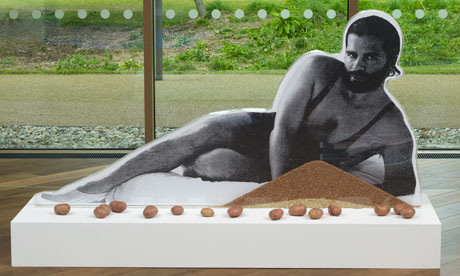Karl Lagerfeld Bean Counter, 2012
Anthea Hamilton (born 1978, London) works with sculpture, painting,
moving-image and performance using the iconography of popular culture
and history to create her own form of contemporary pop art.
http://www.tate.org.uk/whats-on/tate-modern-tanks/music-and-live-performance/anthea-hamilton-kabuki
Man Arch (Pasta) (detail), 2010–11
Walking around Anthea Hamilton's installations can feel like you've
stumbled onto a theatre set without a script. There are plenty of cues
but you have to keep improvising the lines. They typically feature
cut-outs of women's legs in wood or Perspex. There might be artfully
arranged prop-like objects including food, or kimonos, hanging like
costumes, ready to be stepped into. Then there are her blown-up images
of yesteryear's body beautiful: Amazonian gym queens, pouting pin-up
boys and hunks with luscious hairy chests. It's always sexy, funny and
formally seductive.
Yet what to make of this young British
artist's weird conjunctions? The heap of buckwheat for instance, echoing
the cut-out silhouette of a dark-eyed man with a fulsome chest rug
reclining in a low-cut swimsuit? This, astonishingly, turns out to be
the young Karl Lagerfeld, long before the ponytail, big collar and
gloves. It's a shock: another Karl behind another image. A more whole
version, like the wholesome food he's paired with? Maybe. The
associations Hamilton tempts us into making feel as provisional as the
props and wheel-on, inch-thin theatre scenery the work resembles.
http://www.guardian.co.uk/artanddesign/2012/sep/27/artist-of-week-anthea-hamilton
Installation view; Cut-outs, 2007.
Essentially assembling work through a cut-and-paste aesthetic,
Anthea Hamilton takes bricolage to another level by creating installations and
knee-high horizontal assemblages as if she were unpacking a Joseph Cornell. Leo Steinberg’s
analysis of Robert Rauschenberg’s compositional logic as that of a
flatbed picture plane, where information is distributed across a real
horizontal surface as on a desktop rather than in a fictive naturalistic
space, seems equally applicable to the way Hamilton structures her sexy
and playful output.
The sexuality on display also possesses a campy trait, comparable to the arched innuendos of British “Carry On” films, such as Carry On up the Kyhber (1968) or Carry On Matron
(1972). For example, a large reclining black-and-white cutout of a
hairy-chested man in a mankini—or wrestling outfit, which is more
likely—turns out to be a young Karl Lagerfeld, whose sexiness is
deflated by several Désirée potatoes and a pile of buckwheat included in
the piece. Hamilton’s iconography seems to be referring to different
forms of base desire, one the province of the eyes and another of the
stomach.
http://artforum.com/picks/section=uk#picks36442
Gymnasium, 2008
Hamilton’s cut-out legs give a visual rhythm to the installation,
their anthropomorphic shapes inhabiting and activating the space. Not
only do they strongly assert the presence of the artist within her
production – and as such can be understood as a collection of
self-portraits – but they also bring to the work an intensely sensual
mood that verges on the sexual. This titillating atmosphere, very much
in tune with the ancient Greek understanding of the gymnasium (‘a place
to be naked’), is enhanced by the abundance of female shoes, perhaps the
ultimate fetish object in the popular imagination. From the suggestive
(a white vinyl platformed boot) to the romantic (a couple of cute
Cinderella glass slippers), these shoes dress the naked legs to provide
an intricate representation of desire.
Beyond the strictly thematic exploration of the sensuous body and its
representations, ‘Gymnasium’ is also a rich investigation of the
sculptural. Hamilton’s Dadaesque assemblages deftly combine matters and
textures, the organic with the readymade. Sitting on the floor, the
glass shoe is filled with water and topped with a fresh half of lemon;
on the wall, a painted cabbage becomes a lonely desiccated brain. Every
corner of the space is in some way occupied. The various materials
covering (or revealing) the original concrete floor – faux marble vinyl,
mats and cork panels – delimit distinct areas, each strongly identified
by the distinct physical sensations provoked by these contrasting
textures; a spider’s web of vertical ropes and fishing nets visually
answers this complex horizontal pattern.
Hamilton’s concern with the female body echoes the works of an Eva
Hesse, as do the materials that she uses, but the overwhelming presence
of self-representational elements steer this vibrant installation away
from any first-generation feminist political agenda. ‘Gymnasium’ is not
only a stimulating take on the enduring issues of sexuality and desire,
it is also an inspired and enticing mise-en-scene of the self.
Coline Milliard
http://www.frieze.com/shows/review/anthea_hamilton/
Friday 9 November 2012
Subscribe to:
Post Comments (Atom)





No comments:
Post a Comment